Toshiba EMI: Forever Obi Series #2
#16 Hey Jude (AP-8940)
(Update: 23th. October 2024)
 Apple 1st. Sleeve |
|
|
| TITLE | HEY JUDE |
||||
| CATALOG NUMBER | AP-8940 |
||||
| RELEASE DATE | 1974? / Reissue |
||||
| TRACK LISTING | SIDE 1 | SIDE 2 | |||
| Can't Buy Me Love |
Hey Jude |
||||
| I Should Have Known Better |
Old Brown Shoe |
||||
| Paperback Writer |
Don't Let Me Down |
||||
| Rain |
Ballad Of John And Yoko | ||||
| Lady Madonna |
|||||
| Revolution | |||||
| FRONT --> Click! | BACK --> Click! | SIDE 1 --> Click! | SIDE 2 --> Click! | DISK --> Click! | |
 |
 |
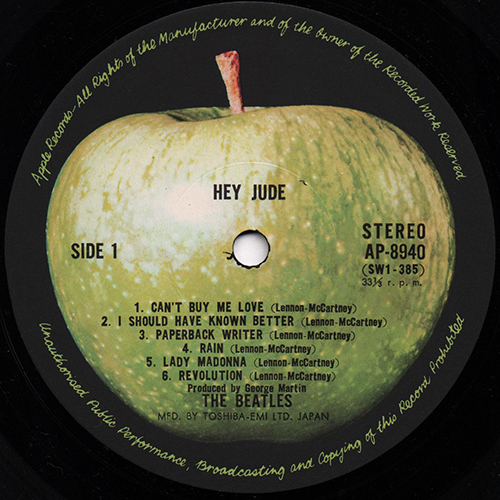 |
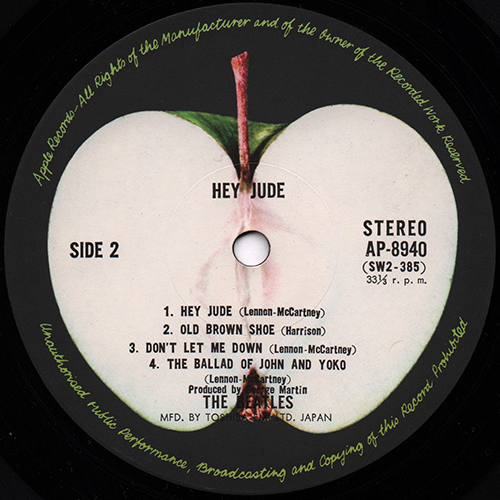 |
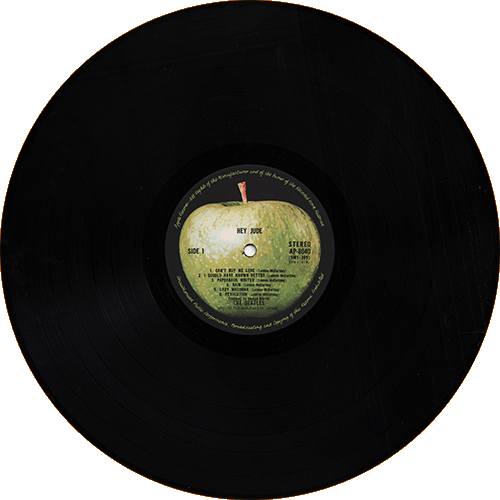 |
|
| INNER SLEEVE | LYRIC SHEET (Slip Sheet Type) | ||||
| FRONT --> Click! | BACK --> Click! | FRONT --> Click! | BACK --> Click! | With Apple custom
black inner sleeve. Lyric sheet: slip sheet type. |
|
 |
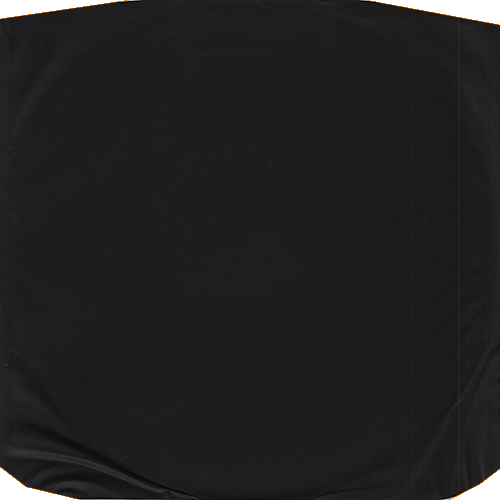 |
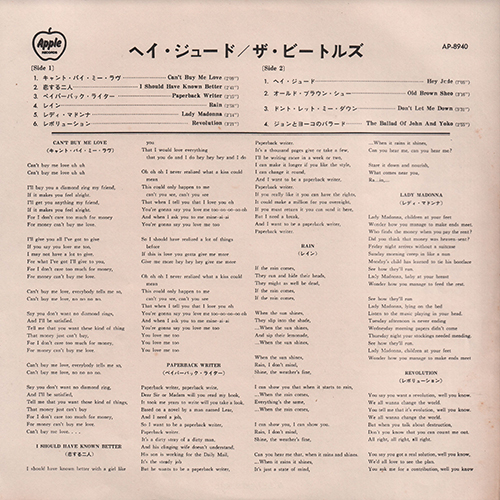 |
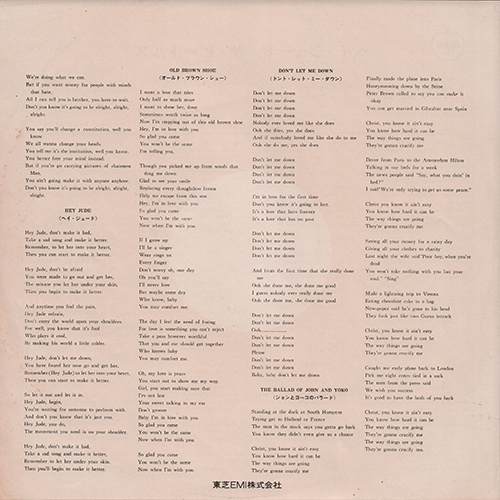 |
||
| FRONT COVER CLOSE UP | BACK COVER CLOSE UP | ||||
 |
Catalogue number and "STEREO" were printed at the upper
right corner of the front cover. |
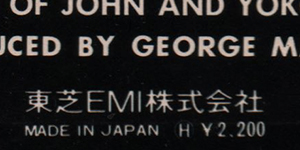 |
The Apple logomark was printed on the front and back
cover. "Toshiba EMI Ltd." and "H ¥2,200" was printed at the bottomof the back cover. |
||
| "FOREVER" OBI: FRONT CLOSE UP | |||||
| OBI: FRONT 1 --> Click! | OBI: FRONT 2 --> Click! | OBI: FRONT 3 --> Click! | |||
 |
 |
 |
 |
||
| catalog number
and price "¥2,200" were printed at the top on obi
strip. |
It is a wide
Obi characterized by the Apple logo at the top, and has a
dark green background. |
The words "The Beatles
Forever" was printed at the bottom. |
|||
| OBI: BACK --> Click! | LYRIC SHEET: CLOSE UP | ||||
 |
The order form was not printed on the obi. | 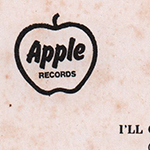 |
 |
||
 |
Company name "Toshiba EMI Ltd." was printed on the lyric sheet. | ||||
| LABEL CLOSE UP | |||||
 |
 |
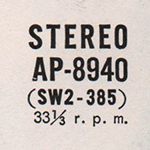 |
The phrase "Apple Records - All Rights of the Manufacturer and of the Owner of the Recorded work Reserved." was printed at the perimeter. | ||
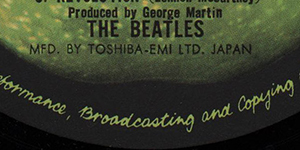 |
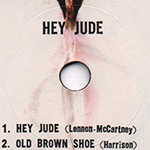 |
The words "MFD. BY TOSHIBA-EMI LTD. JAPAN" was printed at the bottom of the label. | |||
| LABEL CLOSE UP | |||||
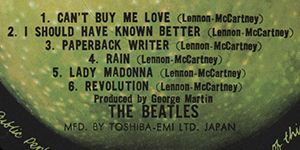 |
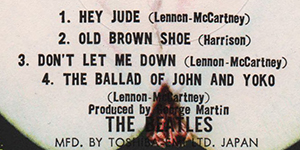 |
Song titles were printed
in narrow sans-serif font on the label. |
|||
|
OTHER ITEM
|
|||||
| - | |||||
| RECORD LABEL | Light Green Apple label Type-2-2 |
||||
| MIX | STEREO |
||||
| MATRIX No. | SIDE 1 | SW1-385
4S 16 |
|||
| SIDE 2 | SW2-385
1S23 50 |
||||
| PRESS MARK | 4-YW |
||||
| VINYL COLOR | BLACK |
||||
| RECORD COMPANY'S NAME | SLEEVE | Toshiba
EMI
Kabusikigaisha |
|||
| LABEL | MFD. BY
TOSHIBA-EMI LTD. JAPAN |
||||
| SYMBOL/PRICE | H - ¥2,200 |
||||
| LYRIC SHEET STYLE | Slip Sheet Type |
||||
| COVER FORM | Single type. Hard cover. |
||||
| INNER SLEEVE |
Apple custom black sleeve |
||||
| OBI |
"FOREVER" Obi (¥ 2,200 / No order sheet) Wide Obi characterized by the Apple logo at the top, and has a dark green background. |
||||
| COVER DESIGN/ PHOTO/ NOTES | Photo: Ethan Russell and Monte
Fresco |
||||
|
COMMENTS
|
Light green Apple
label Type-2-2 with black print. On 1st. December 1973, the record price was raised. The price of the stereo edition has been raised from 2000 yen to 2200 yen. In late (September?)1969, Toshiba had to reissue on the Apple label all the records previously issued on the Odeon label. And in the Apple label, there are two subtypes, TOSHIBA MUSIC and TOSHIBA EMI. Further more, the early copies of the APPLE-TOSHIBA MUSIC type have dark Apple on its label, though the late copies have light one. The Cover Jacket has been changed from a thin sleeve to a sleeve made of thick paper, because it uses thick paper, it is an inner binding type with the glue margin inside. The front and back sleeve is similar to its U.S. counterpart. The album includes most of The Beatles' later singles released in 1968 and 1969 together with both sides of the 1966 single "Paperback Writer". Two rather odd and out of sequence inclusions are "Can’t Buy Me Love" and "I Should Have Know Better" both from the "A Hard Day’s Night" album that were included in place of "The Inner Light" and "Get Back" even though their respective A and B sides, "Lady Madonna" and "Don’t Let Me Down", are included. The Beatles united for a final photographic session on 22 August 1969. It was also the last occasion in which all four members were together for band duties; thereafter their only meetings were business-related. The shoot took place in the house and grounds of Tittenhurst Park, John Lennon and Yoko Ono's home in Sunninghill near Ascot, Berkshire. The couple had moved in earlier in the month, although they had bought the 72-acre estate in May 1969. The photo shoot took place two days after their final recording session together. The photographers were Ethan Russell and Monte Fresco, with additional pictures taken by The Beatles' assistant Mal Evans. The obi: "Forever" Obi This style Obi came into use in the late (October?) 1972 to promote all Beatles releases then currently on the Apple label. The tagline "Beatles Forever" used in Toshiba Onko's campaign began to be used around 1972. It is a wide Obi characterized by the Apple logo at the top, the words "The Beatles Forever" at the bottom, and has a dark green background. This is the first obi that was released with the same design.Forever obi was used in the early 70's, and used for the Beatles, solos, and Apple artist LPs. On 1st October 1973, Toshiba Musical Industries Ltd. was changed its name to Toshiba EMI Ltd. So, there were two kind of Obis --the company name is "Tohiba Musical..." version and "Toshiba EMI..." version. The order sheet was printed for the first Apple Obi but was discontinued in the early years of the Toshiba EMI/Apple Obi (maybe 1974) |
||||